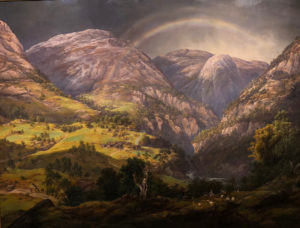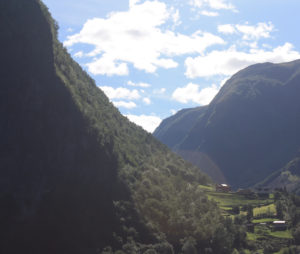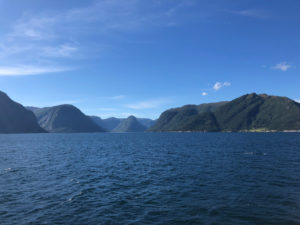I was standing in the theatrically lit second-story gallery of KODE 2 in Bergen with my mouth hanging open, my bag tucked forward under my arm after the security guard told me – first in Norwegian, and then when I sheepishly said I didn’t understand, again in English. As I remember it now, the painting in front of me was bigger than I was in every direction, and depicted a fjord with a double rainbow stretched across it.

I think the most fascinating thing to me about romantic art – that genre of nature towering mercilessly over man – is the exaggerated scale. This is the very definition of our perception of Norway. Particularly western Norway. Fjords, rainbows, idyllic villages.
It might as well have been the cover of our travel guidebook, so the same was this epic depiction by J.C. Dahl, celebrated Norwegian artist. Painted in the 1830s, it was the ideal representation of every travel photo of western Norway ever published.
This all, of course, is a peculiar mythology, an almost fetishization of nature over man. This is, in a confusing way, one of the easiest ways to assure ourselves that there’s no way we could ruin the planet with climate change, because nature is too big. Too powerful. And so we are absolved of responsibility.
The Norwegians, of course, would disagree with this reading of the power of nature (as the exhibit was so astutely named). But it was a hard notion to shake, looking at paintings that are nearly 200 years old, that fully inform how we, now, view these World Heritage sites (and probably contribute to how they arrived at having that designation in the first place). It made me wonder how we could use these stunning paintings, and art more generally, to inform our understanding of the ways that we’re quickly irreparably changing our planet (and not for the better…) – why isn’t all undeveloped land protected until someone proves there is need to develop? But progress must march on – and I’m not so naive to think that just reframing all art as protest is likely to be feasible or successful.
In KODE 3 there was a peculiar exhibit of modern art hidden within the confines of a carefully preserved early twentieth century mansion once belonging to Rasmus Meyer, a collector who’d had the foresight to amass a significant Edvard Munch collection that was donated to the city of Bergen in 1916. The exhibit, called Places to be lost, was composed of peculiar sculptures and innocuous paintings with grotesque and sometimes obscene figures nestled among the preserved sofas and antique sideboards of the mansion. Upstairs, and only accessible after walking through the entire first floor, was the Munch exhibit (I would suspect that most of the visitors to the museum the day Matt and I were there didn’t spend much time with the first part of the exhibit, given how quickly they passed us by, only for us to encounter them again when we finally arrived upstairs). The exhibit continued in one of the other KODE buildings, but we didn’t end up seeing it in full.
In a charming review on TripAdvisor, a fellow Arkansan disparaged the museum. I think it’s worth mentioning here that the museum was unusual: KODE was made up of four separate, relatively small buildings, each housing one or two exhibits, and the entry fee gave you access to all four buildings (and some additional composers’ homes located outside of Bergen). Matt and I visited two of the four, but I think it’s worth acknowledging that if you were under the impression that KODE 3 was all there was on offer it was a somewhat disjointed experience. The reviewer, however, was under the impression that the art on offer was not art of the same quality as could be found in so-called better museums elsewhere, never mind the fact that every museum he mentioned was in a city ten times bigger than Bergen – in those museums I doubt visitors are deliberately directed through a modern art exhibit that could challenge perceptions of what art fundamentally is, or what its purpose should be.
It’s also fair to note: I took no pictures of that challenging art. I have a half dozen pictures of century-old sofas and an antique piano, but it’s the art I saw that I’m still thinking about two weeks later and not the grandfather clock that I have a picture of. And maybe that reviewer was right, those other museums are probably “better,” in that they have more on offer. But I think there’s a lot to be said for deliberately challenging your visitors, and it’s something that I think KODE has achieved remarkably well. That exhibit, and the challenge the artists issued me to think about idyllic nature and the grotesque simultaneously and inexorably intertwined, has stayed with me even as I’ve arrived home to the other side of the planet and fallen headfirst back into my normal life.
Later, riding a ferry through the Sognefjord, surrounded by arguing tourists crowded up against the rail, selfie sticks extended out so that everyone could pretend they had seen the fjords in contemplative solitude (and ruin other people’s similar photos with abandon), I realized that probably this mythology was the same for Dahl, who lived primarily in Dresden and visited Norway five times in his lifetime (his childhood in Bergen doesn’t seem to fit very well into the narrative of his life).

His version probably wasn’t a faithful representation, either. Rearranged for aesthetics, paintings don’t offer a faithful representation any better than a carefully cropped photograph. And yet, walking through gallery after gallery of carefully rendered waves, light and shadow, and clouds gathering over shipwrecks, you begin to believe that what you’re seeing is a faithful representation of what it was like, and the mythology sticks, the romanticism of it permeates our understanding of history. If only I had lived in the 1830s, I wouldn’t have had to deal with the selfie sticks. And these fjords would be somehow more majestic, more dangerous, more beautiful.
At home, flipping through the book Matt and I bought of the exhibit, I was relieved – and a little sad – to find the same sentiment that had troubled me within its pages. We always aim not to be “those” tourists: wasteful, disrespectful, unwilling to see a people and place beyond our own preconceived notions.
Such is the captivating and idyllic visual image of Norway – a landscape and a people that many people have perceived as idiosyncratic and exotic. In modern times the image of Norway created by the romantic painters, which mixes elements of nationalism, sentimentality and idealism, has been taken over by a tourism industry as means to sell values that are in ever-shorter supply: the pristine and the authentic; the beautiful and the exotic; and the exclusive.”
Knut Ormhaug, The Power of Nature, p. 110
I don’t think we visited for an experience that was exclusive, but I think we did think of it as exotic, different, somehow fundamentally more beautiful than other things we have seen closer to home. What we actually saw was a place not so different than the beauty we have here – or, at least, not intrinsically more valuable. And I came home with an intense desire to do better.
